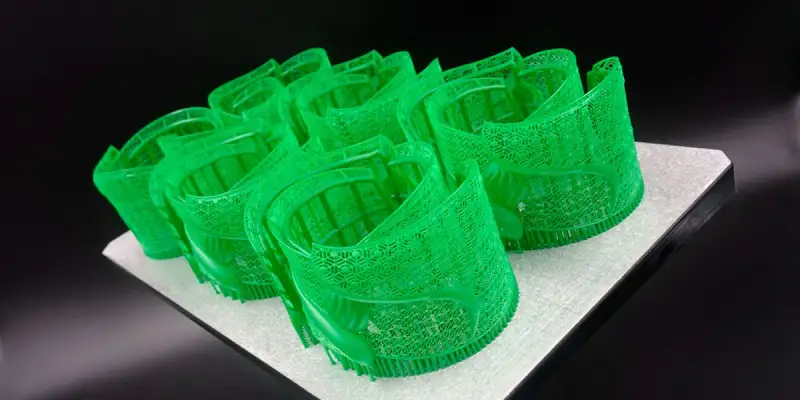ULTIMATE GLOSSARY OF RESIN 3D PRINTING TERMS: EVERYTHING YOU NEED TO KNOW
Resin 3D printing has revolutionized the way we prototype, produce, and cast intricate parts, especially in industries such as jewelry, dental, and precision engineering. Whether you're a beginner or a seasoned professional, understanding the terminology of resin printing can drastically improve your print quality, troubleshooting skills, and workflow efficiency.
To help you navigate this technical landscape, we’ve compiled a comprehensive glossary of resin 3D printing terms that covers everything from printer types to post-processing techniques.
PRINTER TYPES & TECHNOLOGIES
Resin 3D Printing
A layer-by-layer printing process that cures liquid photopolymer resin using light (UV or visible).
SLA (Stereolithography)
Uses a UV laser to cure resin point by point.
DLP (Digital Light Processing)
Projects full layers of light using a digital projector to cure resin all at once.
LCD / MSLA (Masked Stereolithography)
Uses an LCD screen to block UV light and selectively cure layers.
Bottom-up Printing
Cures resin from underneath the vat while the platform lifts upward.
Top-down Printing
Cures from above while the platform lowers into the vat (less common).
RESIN MATERIALS & CHEMISTRY
Resin
Light-sensitive liquid that hardens under UV exposure.
Castable Resin
Designed to burn out cleanly, ideal for investment casting in jewelry or dental.
Wax-Resin Hybrid
Contains high wax content (e.g., 90%+) for better casting performance.
Pigmented Resin
Colored resin that’s often opaque.
Clear Resin
Transparent resin for aesthetic or inspection purposes.
Viscosity
Thickness of resin; impacts flow and exposure settings.
HARDWARE COMPONENTS OF RESIN PRINTERS
Build Plate
Platform where the print adheres and forms.
Vat / Resin Tank
Holds the liquid resin.
FEP Film
Transparent film at the vat’s base, allowing light to pass while minimizing stick.
nFEP / ACF Film
Advanced alternatives that reduce suction and wear.
Long Life VAT
A specially designed vat with improved coatings and materials to resist clouding and extend lifespan over many prints.
Z-Axis Lead Screw
Motorized rod that moves the build plate vertically.
Light Engine
The light source that cures the resin (e.g., laser, DLP projector, UV LED, LCD panel).
PRINTING PROCESS TERMS
Layer Height
The thickness of each printed layer (commonly 10–100 microns).
Exposure Time
How long is light applied to cure each layer.
Bottom Exposure
Longer exposure for the first few layers to ensure strong bed adhesion.
Lift Speed
How fast the build plate rises after each layer is cured.
Peel Process
Separation of the cured layer from the FEP film.
Over-curing
Excess exposure leads to loss of detail or feature bleeding.
Underexposure
Insufficient exposure causes fragile or failed prints.
mm per Hour (Print Speed)
A measure of how fast a resin printer can build vertically in millimeters per hour. Higher speeds are desirable for production environments.
POST-PROCESSING STEPS
Isopropyl Alcohol (IPA)
Common cleaning solvent for uncured resin.
Post-Curing
Additional UV exposure after printing hardens and strengthens the part.
Cure Box
A chamber that emits UV light to cure the print fully.
Support Removal
Detaching support structures after the print is cured.
Resin Washing Station
Device for automated or semi-automated cleaning.
PRINT QUALITY & SUPPORT STRUCTURES
Supports
Temporary structures that prevent sagging in overhangs.
Touchpoints
The small contact spots where the supports connect to the model.
Raft
A wide base that helps prints adhere to the plate.
Overhang
Sections that protrude horizontally and need support.
Islands
Disconnected parts of a layer that require support to avoid failure.
Suction Cup Effect
Vacuum pressure during peel can cause delamination.
Delamination
Layers are separating due to poor adhesion or peel forces.
Z-Banding
Horizontal lines are due to hardware issues or Z-axis inconsistency.
ADVANCED TERMS IN RESIN 3D PRINTING
Anti-Aliasing
Software smoothing to reduce jagged layer edges.
Voxel
A 3D pixel is used to describe resolution and accuracy.
Pixel Size
Refers to the physical dimensions of one pixel on the build area. Smaller pixel size means finer resolution and higher detail (e.g., 35 µm vs. 75 µm).
Pixel Shape
The geometry of each pixel—often square, but in some machines it may be rectangular or custom-shaped. It affects surface smoothness and detail quality.
Grayscale Exposure
Technique to fine-tune light intensity at the pixel level.
Hollowing
Removing interior material to save resin and reduce print time.
Drain Holes
Holes are added to hollow models to let trapped resin escape.
Bleeding
Light spreads unintentionally, curing areas beyond the model's edges.
UV Wavelength
The specific light frequency used to cure resin (typically 405nm or 385nm) . Must match the resin formulation.
FINAL THOUGHTS
Understanding these resin 3D printing terms is essential for anyone working in fields like jewelry manufacturing, dental modeling, miniatures, or engineering prototyping. Whether you’re improving print quality, troubleshooting failures, or choosing the right resin, this glossary will help you speak the language of resin printing with confidence.

